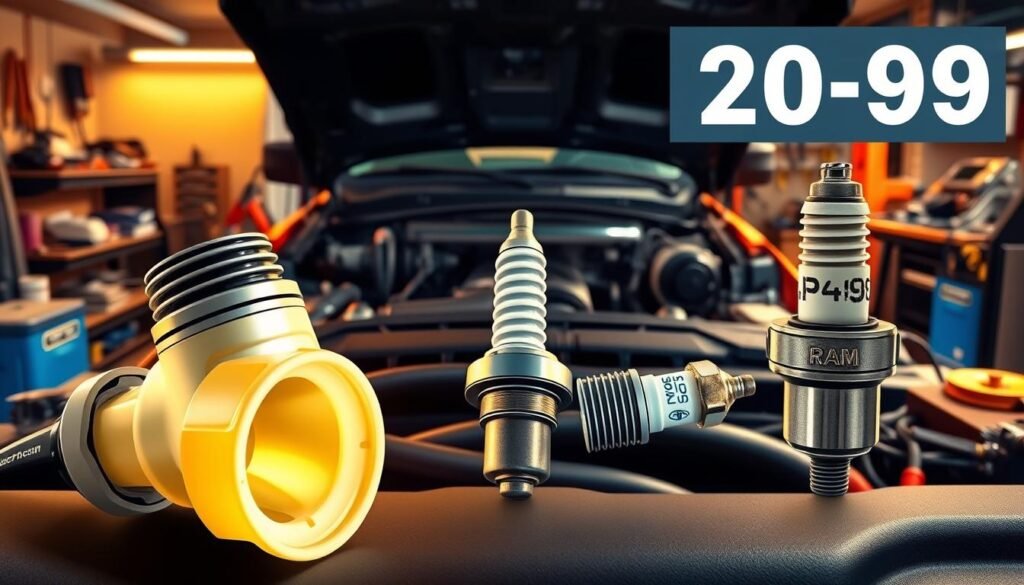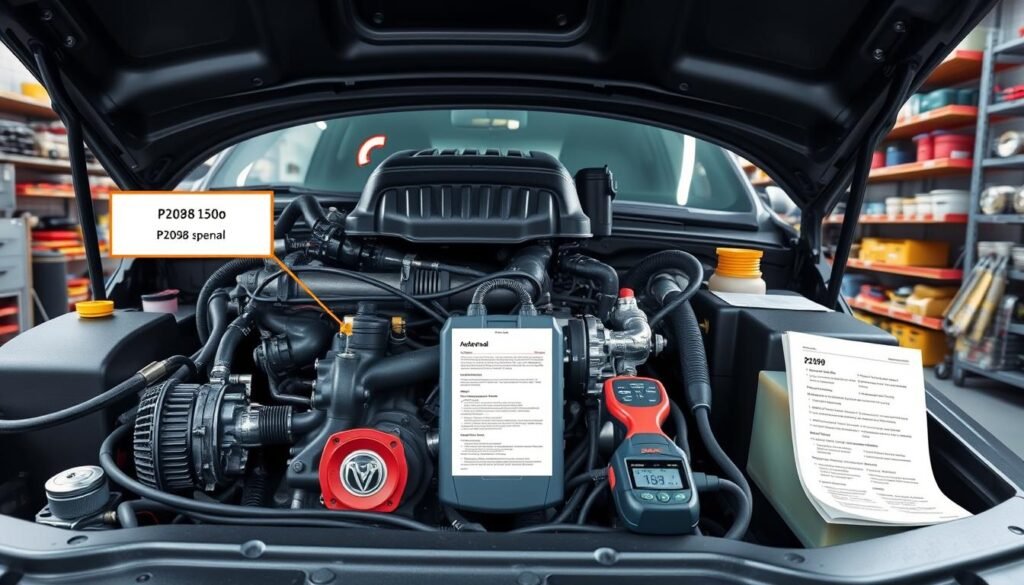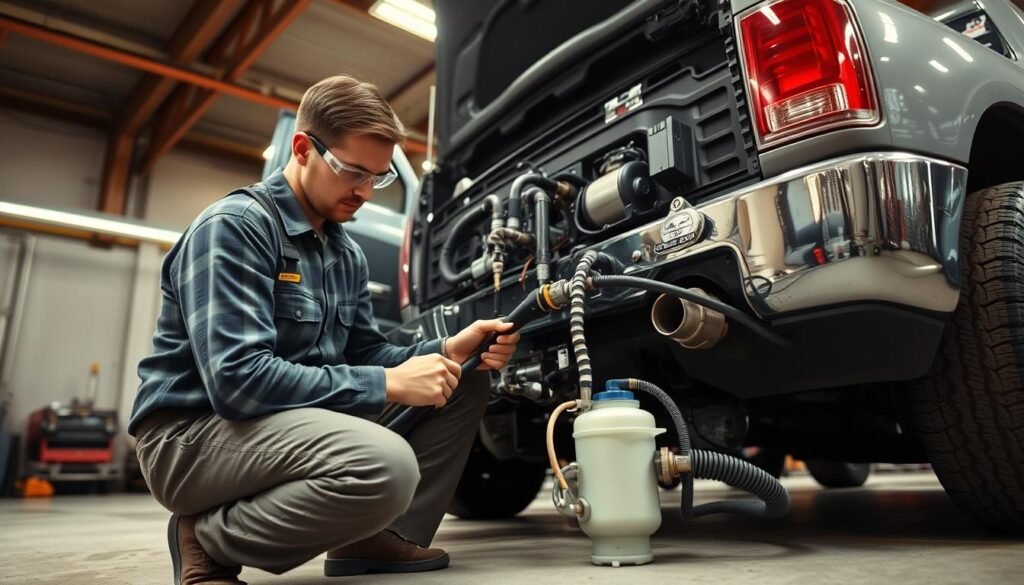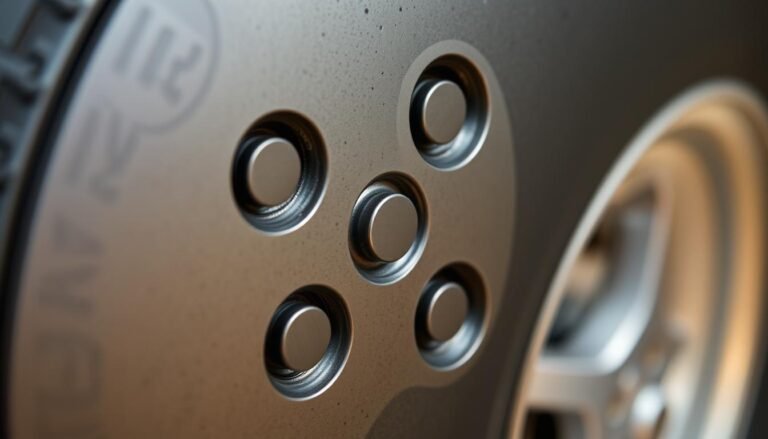P2098 Dodge Ram 1500 Code Fix For – Quick Guide
What does the P2098 code mean for your Dodge Ram 1500? It shows that the sensor after the catalytic converter finds too little fuel in bank 2. This guide will help you figure out and fix the issue with ease.
First, learn about common causes like exhaust leaks, fuel system issues, and sensor circuit problems. Then, you should do a detailed diagnostic.
Use a scan tool to look for trouble codes and inspect the exhaust for leaks. Check the O2 sensor’s wires for damage, too. Finding the problem means you can fix it correctly.
This might involve fixing leaks, changing bad sensors, or solving fuel issues. These steps will get your vehicle running well again.
In conclusion, fixing the P2098 code might seem tough, but it’s quite doable. With the correct methods and some patience, you can find and fix the issue.
Now, let’s get a closer look at the P2098 code, its signs, and how to fix them.
What is The P2098 Code?
Your Dodge Ram 1500 will show the P2098 code if there’s a problem after the catalytic converter in bank 2. This code means the fuel mix is too lean, which can cause many performance issues.
Definition of P2098
P2098 means the air-fuel mix after the catalytic converter for bank 2 is too lean. This might be because of exhaust leaks, bad oxygen sensors, or wiring issues. Knowing this helps with fixing the root problem.
Common Symptoms of The P2098 Code
If your Dodge Ram 1500 shows the P2098 code, you might notice it doesn’t perform well. You may see:
- Illuminated Check Engine Light
- Poor acceleration, feeling slow
- Worse fuel economy, needing more gas
- Hesitation when speeding up, difficult to keep pace
Spotting these signs early can help stop more damage to your car’s engine and exhaust.
Causes of P2098 Dodge Ram 1500
The P2098 code in your Dodge Ram 1500 is linked to fuel system and sensor readings. Knowing why it happens is key to fixing the problem. Here are the main reasons this code shows up.
Exhaust Leaks
Exhaust leaks are a big reason for the P2098 code. They might happen at the manifold gasket or flange. If exhaust gases leak out, the oxygen sensors get wrong readings.
This tricks the ECM into thinking the fuel mixture is too lean, hurting engine performance.
Oxygen Sensor Issues
Oxygen sensor troubles can also cause the P2098 code. These problems include dirty sensors, broken sensors, or wiring issues.
A bad pre-catalyst O2 sensor can mess up fuel trim adjustments, making the lean mixture issue worse. Plus, if the oxygen sensor heater control circuit is faulty, it affects sensor readings and car performance.
Fuel Delivery Problems
Fuel delivery issues are crucial in causing P2098 Dodge Ram 1500. Things like blocked fuel injectors, a weak fuel pump, or dirty fuel limit how much fuel gets to the engine.
This makes the lean mixture problem bigger and requires checking the fuel system and its parts.

| Cause | Description |
|---|---|
| Exhaust Leaks | Can lead to incorrect oxygen sensor readings due to escaping gases. |
| Oxygen Sensor Issues | Includes contamination, circuit faults, and malfunctioning sensors. |
| Fuel Delivery Problems | Restricts fuel flow from clogged injectors or failing pumps. |
P2098 Dodge Ram 1500 Diagnostic Steps
To pinpoint the P2098 code on a Dodge Ram 1500, one must follow structured steps. This begins with a diagnostic check to gather past data on the vehicle’s issues.
Initial Diagnostic Check
Start by looking into the truck’s history to spot repairs on O2 sensors or exhaust parts. It’s crucial to check the vehicle’s troubleshooting guide. Knowing past problems helps in fixing current ones.
Using a Scan Tool
After the history check, use a scan tool next. It helps pull up stored codes and freeze frame data. This info reveals what was happening when the P2098 code appeared, including:
- Scanning for codes and documenting them in the ECM
- Checking freeze frame data for the main failure
- Inspecting the O2 sensors and their wiring for damage or failure
- Checking for exhaust leaks at the manifold gasket or flange
- Verifying the pre-catalyst O2 sensor operation
- Testing the fuel trim system for proper control
Ensure the problem lasts through two drive cycles. After fixing, clear codes and reset the ECM to check the O2 sensors again. Avoid skipping steps like missing freeze frame data, ignoring leaks, and not testing O2 sensors.

Inspection For Exhaust Leaks
Before fixing issues with the exhaust system, it’s crucial to check for leaks. This step includes looking closely and feeling different parts to find any damage. By doing this, we make sure your exhaust works well and safely.
Visual and Physical Inspections
Start with a careful look at the exhaust system when it’s not hot. Check for any cracks, holes, or parts that don’t fit right. Pay extra attention to welded spots, where the O2 sensor fits, and flange connections.
If something seems off, it needs a closer look. You might need to physically check these spots. While checking, use soapy water or special sprays to spot leaks. If you see bubbles, there’s a leak.
Pressurizing The Exhaust System
After checking it over, you might want to pressurize the exhaust to find leaks better. You’ll need special tools like an exhaust cone or air pressure regulator.
Keep the pressure at a safe level—27.6 kPa (4 psi). Then, use a liquid to find leaks and watch for bubbling. Fix small leaks you find in important spots first.
Bigger leaks in less critical areas need fixing too. After repairs, pressurize it again to make sure it’s all fixed.

Checking The Fuel Delivery System
When fixing the P2098 code, it’s important to check the fuel delivery system. This means looking at the fuel pump, filters, and injectors.
If these parts are clogged or not working right, your car won’t get enough fuel, causing a lean condition. Fuel that’s dirty can really harm your fuel delivery system.
It can stop fuel from flowing smoothly and lower your car’s performance. Make sure there’s nothing in the system that shouldn’t be there. Look carefully for any blockages or problems with the fuel injectors.
It’s crucial to test the fuel pressure at the rail to see if the fuel pump is working as it should. If the fuel pressure is too low, you might need to fix or replace parts.
Keep an eye out for signs of trouble with the fuel injectors. These problems can show up even if your car seems to run fine.

To efficiently check your fuel delivery system, follow this guide:
| Step | Description |
|---|---|
| 1 | Inspect the fuel filter for clogs and replace if necessary. |
| 2 | Examine the fuel pump for any signs of malfunction. |
| 3 | Test fuel pressure at the rail; ensure it meets specifications. |
| 4 | Check for fuel injector issues, including leaks and clogs. |
| 5 | Look for evidence of fuel contamination inside the fuel system. |
By following these steps, you’ll get a good look at the state of your fuel delivery system. This can lead to fixing or adjusting parts. It helps in dealing with the problems causing the P2098 code.
Testing The Oxygen Sensors
To effectively figure out what’s wrong when faced with a P2098 code, testing the oxygen sensors accurately is key. It’s important to check the sensor voltage while the engine runs.
Checking this tells you if the sensor’s readings match what they’re supposed to be. Readings that don’t match up could mean there’s a problem with the sensor.
Monitoring Sensor Voltage
Make sure both pre and post-cat O2 sensors work right by watching their voltage. The Engine Control Module (ECM) keeps an eye on these sensors because they’re vital for controlling how much pollution your car makes.
If something seems off while you’re checking them, it’s crucial to test the sensors more closely. This helps avoid big engine troubles.
Checking Wiring and Connectors
Looking at the wiring and connectors for the O2 sensors is also critical. Search for damage, rust, or loose connections that might mess with their function.
Bad wiring can cause wrong data readings, making the P2098 code problems worse. Fixing these wiring issues quickly is important for keeping things running smoothly and accurately.
P2098 Dodge Ram 1500 Code Fix
To fix the P2098 code, you must tackle it step by step. Focus on fixing exhaust leaks, changing oxygen sensors, and fixing fuel problems. Each step is key to make sure your Dodge Ram 1500 runs well.
Repairing Exhaust Leaks
First, check the exhaust system for leaks carefully. Use an exhaust cone (#8404-EC) and an air pressure regulator (#W-18-MIL-1146AS) with 27.6 kPa (4 psi) of air pressure.
Then, use SNOOP leak finder liquid or soapy water to spot any leaks, especially at key points like welded joints and where the O2 sensors are.
Bubbles will show where leaks are. Small bubbles mean minor leaks that need fixing. But, large bubbles mean big leaks that need immediate attention.
Make sure everything is sealed right to avoid wrong readings during inspections. Fix any leaks you find right away.
Replacing Oxygen Sensors
If the oxygen sensors are not working right, replace them. Make sure to use parts approved by the OEM to avoid problems and to keep your truck running smoothly.
A bad oxygen sensor can mess with your gas mileage and make your truck idle roughly. Check how the truck runs after replacing the sensors to make sure everything is fixed.
Correcting Fuel Delivery Issues
If the fuel system has issues, fix them fast. You might need to change a clogged fuel filter or a bad fuel injector to get the fuel flowing right again.
It’s very important to make sure the fuel system works right to stop more problems with the P2098 code.
Resetting The Check Engine Light
After fixing the issues that caused the P2098 code, you must reset the check engine light. This makes sure the engine control module (ECM) forgets the error. You’ll need a specific scan tool for this task.
Steps To Clear The Code
To reset the check engine light, follow these steps:
- Connect a reliable scan tool to the vehicle’s OBD-II port.
- Turn on the ignition, but do not start the engine.
- Access the “Diagnostic codes” section on your scan tool and find the P2098 code.
- Select the option to clear or erase the trouble codes.
- After clearing the codes, disconnect the scan tool from the OBD-II port.
It’s essential to monitor your vehicle for several drive cycles after the reset. Notice if the check engine light turns on again.
This signals whether repairs, like fixing exhaust leaks or swapping out bad oxygen sensors, worked. Clearing the P2098 code this way helps your car run better without false alarms.
Conclusion
Getting to the bottom of the P2098 Dodge Ram 1500 code means taking a close look at exhaust systems, oxygen sensors, and fuel components.
It’s key to fix these step by step to boost your car’s power, save gas, and keep it running well. Take the 2005 Chrysler Sebring Limited 2.7L as an example.
Both oxygen sensors were replaced to fix the P2098 code. But, the problem stayed, showing how tricky this code can be. It reminds us that fixing the P2098 code might need more than one try.
If you ignore the P2098 code, it could make emissions worse and harm your car’s exhaust control parts. The Malfunction Indicator Light (MIL) warns you about these issues for a reason.
By using the right tools, like the OBD-II system, you can handle the code well. This helps your Dodge Ram 1500 last longer and perform better.
FAQs
What does the P2098 code mean for my Dodge Ram 1500?
The P2098 code means that the oxygen sensor after the catalytic converter finds the fuel mix too lean on bank 2. This could mean a problem with how fuel is delivered or with the sensor itself.
How can I fix the P2098 code on my Dodge Ram 1500?
To fix the P2098 code, you need to figure out the issue. This could be exhaust leaks, problems with the oxygen sensor, or issues with fuel getting to the engine. Fix these problems and then clear the code using a scan tool.
What symptoms should I look for if my Dodge Ram 1500 has a P2098 code?
Look out for signs like the Check Engine Light turning on, bad fuel efficiency, and the engine misfiring when speeding up. These could mean there are problems with how the fuel is being delivered.
How do I check for exhaust leaks in my Dodge Ram 1500?
Look over your exhaust system for any signs of damage or loose parts. To find leaks, you can pressurize the exhaust and watch for bubbles which show where leaks are.
What should I inspect in the fuel delivery system?
Check the fuel pump, filters, and injectors to see if they’re working right or clogged. It’s also important to check the fuel pressure to make sure the engine is getting enough fuel.
How can I test my oxygen sensors?
With the engine on, look at the oxygen sensors’ voltage. It should match what the manufacturer says is normal. If not, the sensor might be faulty.
What steps should I take after repairing any identified issues?
Once you’ve fixed the leaks, sensor, or fuel issues, erase the P2098 code with a scan tool. Then, drive your car for a few cycles to check if the Check Engine Light comes back on.







